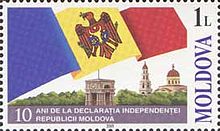- Moldovan Declaration of Independence
-
The Declaration of Independence of the Republic of Moldova (Romanian: Declaraţia de independenţă a Republicii Moldova) was a document adopted by the Parliament of the Republic of Moldova following the failure of the August coup attempt.
The document claims "millenary history" and "uninterrupted statehood" within historic and ethnic borders and names the official language Romanian.[1][2]. This founding act of the Republic of Moldova from 1991 is celebrated on August 27, the National Day or Independence Day.
The Republic of Moldova gained official recognition of statehood on 2 March 1992 when gaining membership of the United Nations.
The original document approved and signed by 278 parliament deputies on 27 August 1991 was burned during 2009 Chişinău riots, but an identical document was restored in 2010.[3][4]
The Moldovan Declaration of Independence clearly and directly claims Moldovan sovereignty over the territory of Transnistria as it is "a component part of the historical and ethnic territory of our people". However the Moldovan Declaration of Independence is itself used as an argument against Moldovan sovereignty over Transnistria as it denounces the agreement of August 23, 1939, between the government of the USSR and the government of Germany "null and void" being the only formal union between the two territories[5].
See also
- Independence Day (Republic of Moldova)
- Dissolution of the Soviet Union
- Disputed status of Transnistria
- Transnistrian Declaration of Independence
References
- ^ (Romanian) Declaraţia de independenţa a Republicii Moldova, Moldova Suverană
- ^ A Field Guide to the Main Languages of Europe - Spot that language and how to tell them apart, on the website of the European Commission
- ^ Moldova restores Declaration of Independence
- ^ Text of Moldova's Declaration of Independence recovered
- ^ Tiraspol Times; Former ASSR Pridnestrovie reminds Moldova: "You yourself denounced our union"
External links
 Moldova topics
Moldova topicsHistory Prehistoric Balkans · Dacia · Principality of Moldavia · Bessarabia · Union with Romania · Greater Romania · Moldavian SSR · War of Transnistria · Post-independenceGeography Cities and regions Law Declaration of Independence · Constitution · Constitutional Court · Nationality law · Passport · Law enforcement · Crime · Human rights · LGBT rightsPolitics Economy Military Demographics Culture See also: Transnistria topics Categories:- Declarations of independence
- 1991 works
- 1991 in law
- History of Moldova
- Moldovan law
- 1991 in Moldova
- 1991 in the Soviet Union
- 1991 in international relations
- History of Soviet Moldova
- Dissolution of the Soviet Union
Wikimedia Foundation. 2010.



